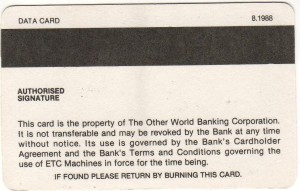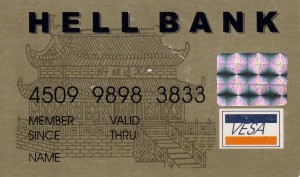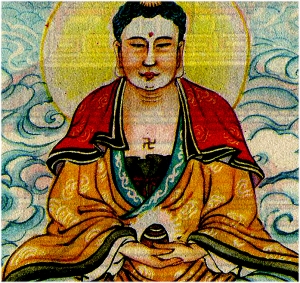Queen Elizabeth II
Many years ago, when I was in Taibei, I found an interesting hellnote. At centre there is a portrait of a lady with a crown. The lady is Queen Elizabeth II of Great Britain! I came to this conclusion because under the portrait of the lady we find four Chinese characters: 冥 英 銀 行 (pin-yin: ming ying yin hang) = The English Underworld Bank.
Near the upper corners we find “100”, but near the lower corners we see “1000”, at right of the portrait “one thousand” is written. On back we find “100” in each corner. So it is not clear whether the note is intended to be a 100 yuan or a 1000 yuan bill.
The note was first issued in 1965, as the “serial” number (really a constant number imitating the serial number of real banknotes) begins with 1965, and we know of several Taiwanese notes from the sixties of the last century where the first four digits of the number give the year of issue.
On the back of the note we find a jet. Planes and ships are often pictured on hellnotes, people wish that the souls in the overworld (or underworld, if you like) may enjoy travelling around…
Inflation in Heaven
Many years ago hell notes had rather low denominations: 1 Yuan, 5 Yuan, 10 Yuan… and in fact such denominations are still in use nowadays. On the other hand we find hell notes with rather high denominations. Accordingly the size of such hell notes is rather big.
I recently came across a hell note in Singapore. It is one of the biggest I have ever seen: 555 x 223 mm! And it bears the highest recorded denomination ever: 100.000.000.000.000 yuan (one hundred trillion yuan).
My scanner is not able to scan such a big note, so I can show only the left portion of the note:
To express such a high figure with Chinese characters the designer of the note had to use a trick, as in normal Chinese language there is no such high figure! He wrote this enormous figure as 壹佰萬億圓 (pin-yin: yi bai wan yi yuan). 壹佰 = 100, 萬 = 10.000, 億 = 100.000.000, hence 100 * 10.000* 100.000.000 = 100.000.000.000.000!
The note, issued by the Underworld Bank 冥通銀行 (pin-yin: mingtong yinhang) shows two persons at left. The old man holding an apple in his hands is “Shou”, the other person is “Lu”, they belong to the Fulushou group of three persons. (Shou refers to “old age”, Lu is a symbol of power). We also find a treasure bowl (symbol of wealth), peonies and herons (symbols of longevity).
Credit Cards
In modern times the dead in the overworld (or underworld, if you like) are in need of credit cards, too. There exist many varieties.
The first example is an imitation of a widely used American Express card (found in Bangkok about 1998):
The back of the card has even an imitation of the magnetic strip found on genuine cards. And there is an interesting phrase at bottom: “IF FOUND PLEASE RETURN BY BURNING THIS CARD”:
Another fine example is the following one (found in Singapore in 2001):
“Vesa” means certainly “Visa”. On this card there even is a holographic structure as a security measure!
The Swastica Symbol (卍)
When in Taibei (Taiwan) a few years ago I found the following hell banknote:
This beautiful 1000 yuan note was issued by the “Underworld Bank” (冥 國 銀 行, pin-yin: mingguo yinhang, literally „Darkland Bank”). It shows a Chinese style Buddhist temple at left, a lotos flower with its seed pod at right. Under the centre of the note there is a red svastica symbol.
The swastika symbol dates back to the Neolithic period. In Buddhist symbolism it has been used as a sign symbolizing good luck. It appears on Buddha’s footprint or on his chest.
The word “swastica” is derived from Sanskrit: “asti” means “to be” (comparable to Latin “est”, German “ist”). The prefix “sv” or “su” modifies the meaning of “asti”, “svasti” means “to be well”.
In Thai there is a (formal) greeting: สวัสดีครับ (pronounced “sawad-deekrup”, used by men) or สวัสดีคะ (pronounced “sawad-deeka”, used by women). This “sawad-dee” is of the same Sanskrit origin as “swastica”.
I learned from a blog (“Thai 101”, by Rikker) that this often heard greeting formula was “invented” by a professor at the Chulalongkorn University around 1935 and in 1943 Field Marshall Plaek Phibunsongkhram (แปลก พิบูลสงคราม) made it the official Thai greeting.
In China the symbol is called “wan” (in Vietnamese “van”), the same word as 萬, meaning “10.000” (originally “myriads”).
Here you can see a swastica symbol on Buddha’s chest (on another hell bank note).I found the note in Bangkok’s chinatown in 2001.
The Phoenix (鳳 凰 )
The divine phoenix is said to remain concealed when the kingdom is unsafe, it appears only in times of peace and prosperity. It is said to have the characteristics of several other beings: the head of a hen, the eye of a man, the neck of a snake, the viscera of a locust, the brow of a swallow…. Other sources describe the phoenix as showing characteristics of different animals…
Its tail has twelve feathers, as a year has twelve months. Consequently, in years with an intercalary month, its tail has thirteen feathers. The phoenix is regarded as a product of the sun, so it is often pictured as gazing on the sun.
By some it is suggested that the phoenix is based upon the folk memories of the “Asian Ostrich” (Struthio asiaticus), that became extinct only after the last ice age, and which –according to archaeological finds- was hunted by the then inhabitants of China…
Originally the male was called “feng” (鳳), while the female phoenix was called „huang“ (凰), and in pictures of the Han times we often find a “feng” and a “huang” facing each other. Later, in the Yuan dynasty, the two words formed a compound word and “fenghuang” became the general term of a “phoenix” connected with female connotations, as opposed to the dragon with male connotations…
Main source: Henry Doré, Researches into Chinese Superstitions
The Peach – a Marvellous Tree and Fruit
Peach wood has been always regarded by the Chinese as a powerful demon-expeller in China. Peach wood can subdue evil influences. A decoction of peach leaves serves as a means to expel spectres from the body. Seals used by Daoist priest were often made of peach wood. In former times, at New Year’s Day, people would drink peach soup. People used to bathe (at full moon) in water in which a twig of the peach tree was soaked. Fever and swoon are regarded as demoniacal diseases, so can be cured by beating persons suffering from such diseases with a peach-rod. People suffering from convulsions, spasms and lethargy can be cured by drinking hot water with peach-blossoms.
De Groot (“The Religious System of China”) gives an explanation why the peach tree is regarded as so powerful: in spring the tree is covered with blossoms before any leaves unfold on its twigs. So people thought that the tree has more vitality than other trees…
The peach fruit is today regarded as a symbol of longevity. In many Chinese homes a picture of a peach fruit can be found; people think that this picture may prolong their lives…
Several hell notes show a peach fruit. Often it is held by children:
Main source: Henry Doré, Researches into Chinese Superstitions, 1917
Fulushou (福 祿 壽 )
Fu (福), Lu (祿),and Shou (壽)are three very important „gods“ in Chinese mythology. They represent luck, wealth and longevity respectively. There are regarded as astral deities, as they are related to the three stellar gods: Fuxing, Luxing, and Shouxing.
Fuxing (福星) is the god of luck. His original name was Yang Cheng, who in the 6th century was a civil servant in Dazhou, Hunan province. Pictures or statues often show him carrying a child.
In the 6th century Dazhou was known for its dwarfs. The emperor ordered many of the dwarfs to be sent to him for his entertainment. The people of Dazhou had to obey the emperor, but Yang Cheng wrote a petition to the emperor and the dwarfs could soon return to their homes. So the people of Dazhou paid homage to Yang Chen for saving their children. After his death Yang Chen was worshipped and became a god…
Luxing (祿星)is regarded as god of promotions and raises. He is said to be a deification of a civil servant of the 2nd century. In life, Luxing bore the name Shi Fen. He was born into a very poor family, but through hard working and constant learning he finally got a high position and became a favorite of the Emperor Jing. Pictures or statues of him usually show him in the typical dress of a civil servant with a winged hat. He often holds a Ruyi in his hands, which is a kind of scepter and a symbol of his power (usually only emperors can have a Ruyi).
Shouxing (壽星)is the god of longevity. He is depicted as an old man with a white beard and an high forehead. He holds a huge peach in his hand, it is a special peach found only in heaven; they ripen only every 3000 years. People believed that a bite of this celestial peach would give immortality…In the other hand Shouxing holds a stick, made of peach wood.
Here I show two pictures of Hell banknotes with the Fulushou group. This note was recently found in Bangkok:
The second note (found in 2007 in Hongkong) shows the Fulushou group on its left side:
A Traditional Hell Note
Hell banknotes are paper money for the overworld. They are burned by relatives or friends for the dead to enable the souls to have an agreeable life. To burn such notes for the dead is regarded as a duty of all Chinese.
The notes show a denomination ranging from 1 to 100.000.000 yuan or even much more… It is thought that when burning the notes their value will rise with the smoke to the dead… Burning is thought of as an act of purification…
Often we find two different seals or/and signatures on the notes. Usually the right signature is that of the “jade emperor” and director (行 長) of the hell bank. His name is “Yu Huang” (玉 皇). He has been officially worshipped in China since the times of the Song emperor Zhen Zong (998 – 1923). Yu Huang is a very popular god in China, comparable to the Greek Zeus and the Roman Jupiter. The Taoist regard him as their highest god, although the Buddhist claim Yu Huang was originally one of their gods and was only taken over by the Taoists…
The second seal or signature is that of the vice director (副 行 長) of the bank of hell, Yan Luo (閻 羅). He is regarded as a “prince in hell”, some claim he is the most important one. He is identical to Yama the Vedic god of the dead.
The hell note shown here is only one of thousands of different ones in my collection – I have been collecting hell notes for nearly 50 years and will successively –as time allows me- describe and picture some of the more outstanding examples in my blog.
The note pictured here was found recently in Macao. It is one of the old style notes, with red and green colours only. At the centre there is a portrait of Yu Huang. The title of the note is 冥 通 銀 行 (ming tong yin hang) which means “Mingtong Bank”, “ming” being the word for “underworld”. Below the portrait we find 通 用 冥 幣 (tong yong ming bi) which can be translated as “money to be used in the underworld”. The denomination is rather high: 50.000.000 Yuan.













